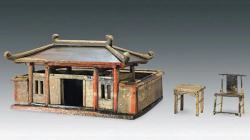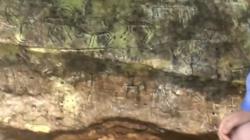INSTITUT SUPERIEUR D'ANTHROPOLOGIE
INSTITUTE OF ANTHROPOLOGY
ONLINE COURSES / COURS A DISTANCE
FALL TERM : OCTOBER 2018
REGISTER NOW
NORVEGE – 
 Halden - Archaeologists have discovered traces of a Viking ship buried beneath a field in Norway, a rare find that could shed further light on the lives of Vikings. The amazing discovery was made by archaeologists from the Norwegian Institute for Cultural Heritage Research (NIKU) in Halden, southeast of Oslo. This find is incredibly exciting as we only know three well-preserved Viking ship finds in Norway excavated long time ago,” Dr Knut Paasche, head of Digital Archaeology at NIKU said. “This new ship will certainly be of great historical significance as it can be investigated with all modern means of archaeology."Using high resolution georadar, the group detected the remains of the ship, a number of burial mounds and five longhouses. The ship was laid only 50 centimeters underground, inside a burial mound known as a tumulus. We are certain that there is a ship there, but how much is preserved is hard to say before further investigation,” said Morten Hanisch, county conservator in Østfold. Digital data visualisations reveal a 20-meter-long ship-shaped structure, the NIKU said. The images suggest the lower part of the ship is preserved.The team hope to carry out more non-invasive investigations to digitally map the area. This way, they can learn more about the ship without exposing it to the elements. They haven’t ruled out eventually excavating the ship.
Halden - Archaeologists have discovered traces of a Viking ship buried beneath a field in Norway, a rare find that could shed further light on the lives of Vikings. The amazing discovery was made by archaeologists from the Norwegian Institute for Cultural Heritage Research (NIKU) in Halden, southeast of Oslo. This find is incredibly exciting as we only know three well-preserved Viking ship finds in Norway excavated long time ago,” Dr Knut Paasche, head of Digital Archaeology at NIKU said. “This new ship will certainly be of great historical significance as it can be investigated with all modern means of archaeology."Using high resolution georadar, the group detected the remains of the ship, a number of burial mounds and five longhouses. The ship was laid only 50 centimeters underground, inside a burial mound known as a tumulus. We are certain that there is a ship there, but how much is preserved is hard to say before further investigation,” said Morten Hanisch, county conservator in Østfold. Digital data visualisations reveal a 20-meter-long ship-shaped structure, the NIKU said. The images suggest the lower part of the ship is preserved.The team hope to carry out more non-invasive investigations to digitally map the area. This way, they can learn more about the ship without exposing it to the elements. They haven’t ruled out eventually excavating the ship.
VIDEO = https://www.rt.com/news/441329-viking-ship-norway-field/
CHINE - 
 Tieguai - Archaeologists in China have uncovered the tomb of a 900-year-old preserved skeleton nicknamed the "Grand Lady." The remains of the body were uncovered in a water-filled coffin within a tomb at Tieguai Village in China. The skeleton was buried with various other artifacts, such as a model house with miniature furniture inside and a silver pendant decorated with dragons. A sign found on the coffin said the tomb belonged to the "Grand Lady" who lived in "Ankang Commandery." While her actual name was difficult to read on the sign, the archaeologists believe it could be née Jian, LiveScience reports. "The skeleton [of the Grand Lady] is essentially preserved, complete with fingernails and hair," the team wrote in the Chinese Cultural Relics journal. One indication of the Grand Lady’s age came from the 200 bronze coins located within her coffin produced between roughly A.D. 713 and A.D. 1100. The archaeologists said she probably died around A.D. 1100. This clue made sense since that time period marked the Song dynasty when culture and art prospered in the region. The Grand Lady had ornate style as she was found wearing silver and gold hairpins on her head, silver bracelets on her arms, and a string of 83 bronzed coins on her abdomen. Beneath her right hand were the remains of two zongzi or what was left of two rice dumplings. She was also buried with other grave goods and many small replicas of real-life objects. Within her tomb, there were 10 female figures wearing masks and playing musical instruments. Portraits were in her coffin which were likely of the Grand Lady wearing different clothes and accessories. The discovery is fascinating because many artifacts were still housed within the tomb. Oftentimes, tombs are looted by robbers such as the one found next to the Gray Lady that was likely one of her family members, according to the archaeologists.
Tieguai - Archaeologists in China have uncovered the tomb of a 900-year-old preserved skeleton nicknamed the "Grand Lady." The remains of the body were uncovered in a water-filled coffin within a tomb at Tieguai Village in China. The skeleton was buried with various other artifacts, such as a model house with miniature furniture inside and a silver pendant decorated with dragons. A sign found on the coffin said the tomb belonged to the "Grand Lady" who lived in "Ankang Commandery." While her actual name was difficult to read on the sign, the archaeologists believe it could be née Jian, LiveScience reports. "The skeleton [of the Grand Lady] is essentially preserved, complete with fingernails and hair," the team wrote in the Chinese Cultural Relics journal. One indication of the Grand Lady’s age came from the 200 bronze coins located within her coffin produced between roughly A.D. 713 and A.D. 1100. The archaeologists said she probably died around A.D. 1100. This clue made sense since that time period marked the Song dynasty when culture and art prospered in the region. The Grand Lady had ornate style as she was found wearing silver and gold hairpins on her head, silver bracelets on her arms, and a string of 83 bronzed coins on her abdomen. Beneath her right hand were the remains of two zongzi or what was left of two rice dumplings. She was also buried with other grave goods and many small replicas of real-life objects. Within her tomb, there were 10 female figures wearing masks and playing musical instruments. Portraits were in her coffin which were likely of the Grand Lady wearing different clothes and accessories. The discovery is fascinating because many artifacts were still housed within the tomb. Oftentimes, tombs are looted by robbers such as the one found next to the Gray Lady that was likely one of her family members, according to the archaeologists.
https://www.foxnews.com/science/ancient-grand-lady-skeleton-uncovered-in-chinese-tomb
BULGARIE – 
 Sozopol - Archaeologists have discovered an impressive tomb from the second half of the 4th and the beginning of the 3rd century BC to rescue excavations on the northern slope of the Budjaka Hill. In the embankment, with an area of about 180 square meters, they discovered the largest family tomb known since the studies of the necropolis of Apolonia. It has a rectangular shape, 6.2 x 8 meters. The outer walls are made of massive well-formed quads without soldering. It revealed the skeleton remains of two women and one man, probably members of a rich Apollo family. Two of the graves are of the cist type in which the rectangular grave chamber and the coating are made of solid stone blocks. In the central grave there is a scattered burial inventory. The walls of the burial chamber are colored in red (the color of the reincarnation). The analysis of the findings leads to the scientific hypothesis that the grave is for a woman. An analogous facility is in the southeast corner. In it are laid the remains of a male with richer and varied tomb gifts - two bronze stalks, olpe and leciths (pottery). On the cover of the second grave, the remains of a woman are laid on a stone platform. This is the latest burial in the tomb's volume, after which the mound is buried. The analysis leads to the conclusion that the tomb is from the time when the Black Sea polis and surrounding Thracian dynasties were conquered by the Macedonian Empire of Alexander the Great and his successor Lysimachus.
Sozopol - Archaeologists have discovered an impressive tomb from the second half of the 4th and the beginning of the 3rd century BC to rescue excavations on the northern slope of the Budjaka Hill. In the embankment, with an area of about 180 square meters, they discovered the largest family tomb known since the studies of the necropolis of Apolonia. It has a rectangular shape, 6.2 x 8 meters. The outer walls are made of massive well-formed quads without soldering. It revealed the skeleton remains of two women and one man, probably members of a rich Apollo family. Two of the graves are of the cist type in which the rectangular grave chamber and the coating are made of solid stone blocks. In the central grave there is a scattered burial inventory. The walls of the burial chamber are colored in red (the color of the reincarnation). The analysis of the findings leads to the scientific hypothesis that the grave is for a woman. An analogous facility is in the southeast corner. In it are laid the remains of a male with richer and varied tomb gifts - two bronze stalks, olpe and leciths (pottery). On the cover of the second grave, the remains of a woman are laid on a stone platform. This is the latest burial in the tomb's volume, after which the mound is buried. The analysis leads to the conclusion that the tomb is from the time when the Black Sea polis and surrounding Thracian dynasties were conquered by the Macedonian Empire of Alexander the Great and his successor Lysimachus.
https://www.novinite.com/articles/192622/Bulgarian+and+French+Archaeologists+Discovered+an+Impressive+Tomb+in+Sozopol
TURQUIE – 
 Lake Ataturk Dam - A fisherman has stumbled across what is believed to be a stone age human carving, after a drought exposed the walls of one of the world's largest reservoirs. The carving, which dates back to the Palaeolithic - or old Stone Age - era, according to local media, shows hunting scenes and features animals and birds including wolves and horses. It is eight metres long and 70 centimetres high, and was exposed after the water levels in the reservoir dropped around 10 to 15 metres. Mr Alkan said he believed the engraving dated back around 40,000 years and would have had a religious significance to the people who carved it into the rocks.
Lake Ataturk Dam - A fisherman has stumbled across what is believed to be a stone age human carving, after a drought exposed the walls of one of the world's largest reservoirs. The carving, which dates back to the Palaeolithic - or old Stone Age - era, according to local media, shows hunting scenes and features animals and birds including wolves and horses. It is eight metres long and 70 centimetres high, and was exposed after the water levels in the reservoir dropped around 10 to 15 metres. Mr Alkan said he believed the engraving dated back around 40,000 years and would have had a religious significance to the people who carved it into the rocks.
VIDEO = https://www.mirror.co.uk/news/world-news/huge-hunting-scene-discovered-fisherman-13419495